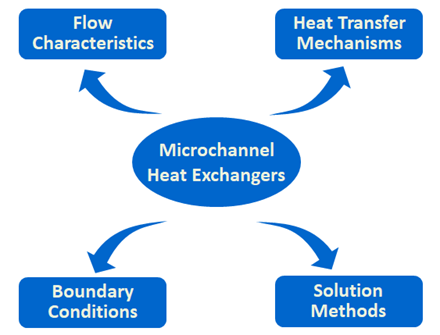Continuously improving heat transfer efficiency is one of the important goals in the energy field. Compact heat exchangers characterized by microscale flow and heat transfer have successfully provided solutions for this purpose. However, as the characteristic scale of the channels decreases, the flow and heat transfer characteristics may differ from those at the conventional scale. When considering the influence of scale effects and changes in special fluid properties, the flow and heat transfer process becomes more complex. The conclusions of the relevant studies have not been unified, and there are even disagreements in some aspects. Therefore, further research is needed to obtain a sufficient understanding of flow structure and heat transfer mechanisms in microchannels. This article systematically reviews the research about microscale flow and heat transfer, focusing on the flow and heat transfer mechanisms in microchannels, which is elaborated into the following two perspectives: one is the microscale single-phase flow and heat transfer that only considers the influence of scale effects, the other is the special heat transfer phenomena brought about by the coupling of microscale flow with special fluids (fluid with phase change (pseudophase change)). The microscale flow and heat transfer mechanisms under the influence of multiple factors, including scale effects (such as rarefaction, surface roughness, axial heat conduction, and compressibility) and special fluids, are investigated, which can meet the specific needs for the design of various microscale heat exchangers.
- microchannels
- single-phase
- scaling effects
- phase change
- flow boiling
- pseudophase change
- flow structures
- heat transfer mechanism
- Introduction
The escalating energy demand has led to a gradual increase in resource scarcity and environmental degradation. Consequently, policymakers and regulators in numerous countries have opted to prioritize the enhancement of energy conversion efficiency and the restructuring of energy distribution. This has resulted in a surge of research interest in improving the efficiency of heat engines and heat exchangers [1]. In particular, compact heat exchangers are gradually replacing traditional heat exchangers, which can ensure efficient heat exchange tasks under more stringent space and weight constraints. Compact heat exchangers are usually composed of micro/small heat exchange units or microscale channels. Compared to conventional large-scale channels, they have an extremely high surface area to volume ratio and several orders of magnitude higher heat transfer performance [2]. Compact heat exchangers have become the preferred choice in many practical applications. With the improvement of manufacturing technology and heat transfer enhancement technology, various new types of microchannel heat exchanger configurations have been proposed and widely applied in many fields, as shown in Figure 1, including nuclear energy[3,4], solar thermal[5], molten salt fuel cells[6,7], microelectronic micro mechanical systems[8,9], automotive cooling systems[10,11], aerospace (active regenerative cooling systems, precooled propulsion systems, etc.)[12-21], and so on.

Figure 1. Applications of microscale flow and heat transfer in industrial fields
The working state of compact heat exchangers can be attributed to the physical process of microscale flow and heat transfer. Research on microscale flow can be traced back to the 1840s, when Poiseuille et al. [22] published their first paper describing flow in pipes with diameters ranging from 30 to 150mm. In 1909, Knudsen et al. [23] studied gas flow through glass capillaries in transition and free molecular flow schemes. In 1913, Gaede et al. [24] conducted the first known parallel microchannel flow experiment. Microfluid devices have a significant advantage in heat transfer due to their extremely high surface area to volume ratio, which naturally attracts the attention of researchers in the field of heat transfer. In 1981, Tuckerman et al. [25] first proposed the concept of microchannel heat sinks and demonstrated that reducing channel size can significantly improve the heat transfer performance of heat sinks. Afterwards, with the urgent demand for compactness in different industrial systems, by the 1990s, microchannel fluid dynamics received widespread attention and created a scientific research field for microfluidics [26].
Despite the increasing applications of microscale heat transfer in science and engineering, including constant property fluid type, boiling type, supercritical fluid type, nano-fluid type, etc., and extensive research has been conducted in this field, no unified conclusion has been reached on the fluid dynamics and heat transfer processes. Therefore, it is necessary to deeply understand the characteristics of microscale flow and heat transfer, and explore the mechanism of microscale flow and heat transfer under the influence of multiple factors including scale effects (rarefaction effects, surface roughness, axial heat conduction, Compressibility effects, etc.) and special fluids, which will meet the various requirements for the design of different microscale heat exchangers.
The literature on microchannel heat exchangers can be classified based on fluid flow characteristics, heat transfer mechanisms, boundary condition types, and solution methods [27], as shown in Figure 2. This article focuses on the mechanism of flow and heat transfer in microchannels, so it will be elaborated from the following two perspectives. The first type is the microchannel flow and heat transfer mechanism that only considers the influence of scale effects in the single-phase fluid flow through microchannels. The second type is the complex flow and heat transfer mechanism reflected by the coupling of microchannels flow and special heat transfer phenomena brought about by special fluids (fluid with phase change (pseudophase change)). A systematic review was conducted on the current research status of microchannel flow and heat transfer, and the results were summarized.

Figure 2. Classification diagram of microchannel heat exchangers.
- Conclusions
This article systematically reviews the microscale flow and heat transfer research, focusing on the flow and heat transfer mechanisms in microchannels. The microscale flow and heat transfer mechanisms under the influence of multiple factors, including scale effects (such as rarefaction, surface roughness, axial heat conduction, and compressibility) and special fluids, are investigated, which can meet the specific needs for the design of various microscale heat exchangers. The results can be summarized as follows:
(1)The current research on flow and heat transfer characteristics in the microchannel can be divided into two categories: one is the microscale single-phase flow and heat transfer, which excludes the effect of fluid physical properties changes and focuses on the mechanism of the scale effects due to the reduction of the channel size. The other is the application of special fluids (fluid with phase change (pseudophase change)) in microchannels, which brings about the coupling of the scale effects with the change of the physical properties, and the overall heat transfer performance is further enhanced. However, most of the studies in this field have focused on the flow and heat transfer characteristics of special fluids in microchannels, rather than on the scale effects in particular.
(2) For the flow and heat transfer mechanisms of single-phase fluid in microchannels, it is first necessary to determine whether the flow satisfies the continuity assumption by the Kn number. If Kn<0.001, the flow is regarded as continuous. Although the basic equations and physical laws at conventional scales are applicable, scale effects (rarefaction effects, surface roughness, wall axial heat conduction, compressibility, etc.) must be taken into account, which is an important reason for the deviation of macroscopic classical flow and heat transfer theories in microchannel single-phase flow. If Kn>0.001, the assumption of continuity no longer holds, and rarefaction effects become significant. It is necessary to modify the boundary conditions (slip velocity, temperature jump) or apply molecular dynamics theory to solve the difference between classical continuum flow and molecular transport flow.
(3) The flow boiling heat transfer mechanism in microchannels is very different from that in conventional channels. In the boiling heat transfer process of microchannels, the development of bubbles goes through a series of dynamic processes that include bubble nucleation, growth, departure, and movement along the flow direction. However, the development patterns of conventional scale flow patterns are often unable to predict flow pattern transitions in microchannels. It is necessary to consider more influencing factors, such as bubble constraints, channel size, and shape effects. The above factors play an important role in flow heat transfer characteristics, as well as various flow instabilities.
(4) For the flow and heat transfer mechanism of the fluid with pseudophase change in microscale channels, the significant change of physical properties in the transcritical process leads to dramatic velocity fluctuations, which directly affects the turbulent burst behavior of the flow field (ejection event Q2 and sweep event Q4). Buoyancy and thermal acceleration are considered as indirect effects on the flow field, which may lead to the attenuation of turbulence intensity and reduce the ability of turbulent heat transfer. In addition, the mechanisms of different heat transfer modes for supercritical pressure fluids in microchannels have not been unified. In particular, how to maximize the performance of heat transfer enhancement while effectively avoiding heat transfer deterioration remains to be further studied.
This entry is adapted from the peer-reviewed paper 10.3390/mi14071451
